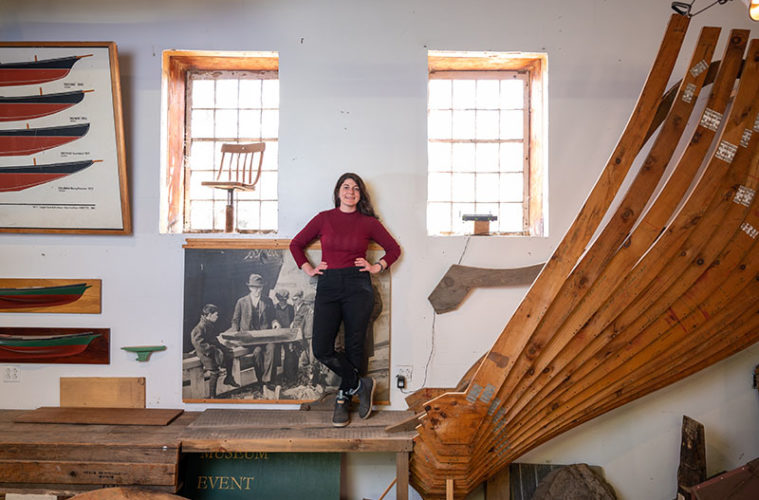About 10 new families moved to Essex last year, which might not sound like much at first, but as KD Montgomery, executive director of the Essex Historical Society and Shipbuilding Museum, notes, it’s quite a lot when you consider that the town’s population is only about 4,000 people.
That’s not the only thing that’s different about Essex. It’s also a place where undeveloped areas are mostly held in land trusts or owned by families who’ve been passing them down through generations, preserving the natural landscape, and where traditional industries like clamming still thrive.
“Essex is a uniquely rural community, surrounded by urbanized areas, but we’re still a small town with a small population,” Montgomery says. “The culture of Essex was really built around farming and shipbuilding and harvesting clams. A lot of people still earn their living that way.”

That’s why Essex is a perfect place to host “Crossroads: Changes in Rural America,” a traveling exhibit produced by the Smithsonian Institution’s Museum on Main Street program that explores how rural American communities changed in the 20th century. Museum on Main Street works with state humanities councils to bring the traveling exhibit to their states. The councils then select and work with local communities to bring the exhibit to different towns.
Essex is one of six Massachusetts towns that Mass Humanities selected for the exhibit. The Essex Historical Society and Shipbuilding Museum will host the exhibit from September 10 to October 22, before it travels to sites in Hull, Rutland, Turners Falls, Sheffield, and Athol through June 2023.
Brian Boyles, executive director for Mass Humanities, echoes Montgomery in noting Essex’s unique position as a rural, coastal community nestled between many urban and suburban ones.
“For us, that’s really, really fascinating, because development is a pressure that’s caused a lot of change in rural America and rural Massachusetts,” he says. “And a community near the coast is also something that’s fascinating to know more about.”

The exhibit covers five big-picture themes as they relate to the changing dynamics of rural America: Identity, land, community, persistence, and managing change, says Selwyn Ramp, project director of the Museum on Main Street for the Smithsonian Institution Traveling Exhibition Service.
Since “Crossroads: Changes in Rural America” is a nationally traveling exhibit, the themes are broad, but each host community interprets that theme in its own unique way. Each site also receives training from the Smithsonian staff and a $10,000 grant from Mass Humanities to develop its public events during the exhibit.
“It’s not just…putting an exhibition on a truck and it shows up in Massachusetts,” Ramp says. Instead, it’s building a foundation and a conversation starter for community-specific programming.
In Essex, the physical exhibit from the Smithsonian will be held in the town hall’s exhibit space, while the programming and additional complements to the main exhibit will be at the Essex Historical Society and Shipbuilding Museum.
Local partners are in the process of developing about eight different programs that aim to “bring attention to the really unique and powerful histories that we have in this town,” Montgomery says. Montgomery is particularly excited about an Essex-themed “Dungeons and Dragons” game that students at Manchester Essex Regional High School are creating.
The students are researching in the town archives to develop their game, which will include a map of town and real-life people from Essex histories with different storylines. A role of the dice might change those stories.
There will be opportunities to play the game during the exhibition itself, as well as after, since the group will be developing an accompanying “dungeon master” gameplay manual. They’ll teach the game to younger students and leave a physical copy of the manual at the town library, where people meet regularly to play “Dungeons and Dragons,” allowing the game to carry on even after the exhibit packs up and heads to the next town.
That concept of continuing programming even after the exhibit officially concludes is important to the people behind the Smithsonian Institution’s Museum on Main Street program, which is why Mass Humanities will also provide another year’s worth of funding to continue that work and interest.
“Too often when you fund a project like that, they do a ton of work, get together, they might do one event, and then the exhibition goes and they’re not able to keep the momentum going,” says Boyles.
“We want to make sure they have that opportunity to keep that momentum going because we do feel that these small local organizations are the places where people really will meet and imagine what’s going to happen tomorrow.”
Montgomery says she hopes that the exhibit and its Essex-specific programming will reinvigorate longtime residents’ appreciation of their town’s roots and inform newcomers about the “beautiful and unique and fertile and maritime nature of who we are on the North Shore.”
CONTACT sites.si.edu

